#daeva indra
Explore tagged Tumblr posts
Text
Crack animation 2: Crispmas. There's a HP/MP bar because in the initial scene it was meant to look like someone actually playing a game and switching around party members to decorate the room.
Never finished for the same reason as the other one: I forgot the script/plot. Was making these between school/college activities, and then like... Woops.
Why are the daeva just chilling there with the druids having "Crispmas party" together together and everything's fine? It was supposed to be explained in the thing, but yeah, silly me for not actually writing down the script.
Funny scenes from the "footage" I already did:
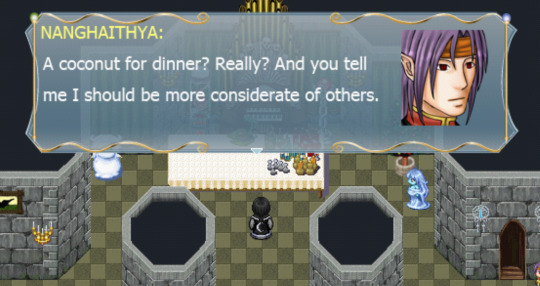
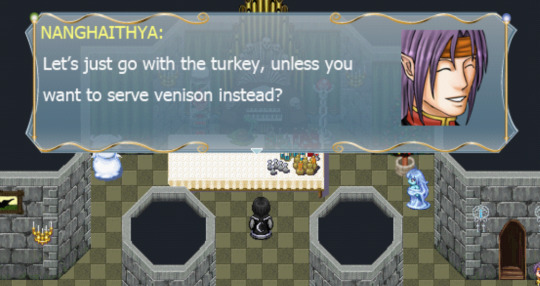
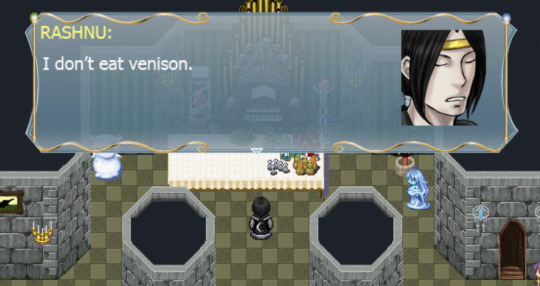
Inside joke about venisons from Ye Olde Forums (courtesy of @druidofdarkness).
Breaking the Fourth Wall
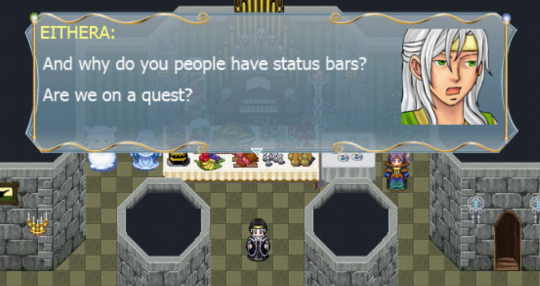
And references to AV3
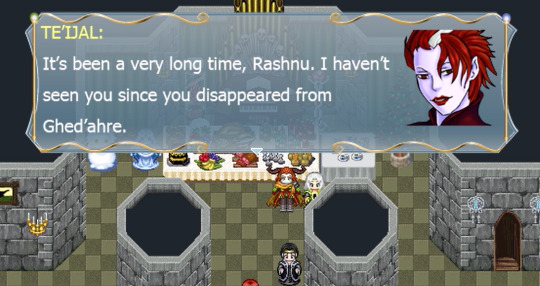
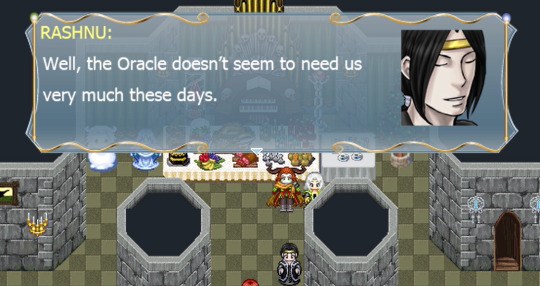
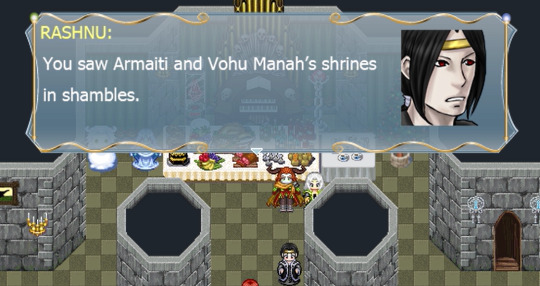
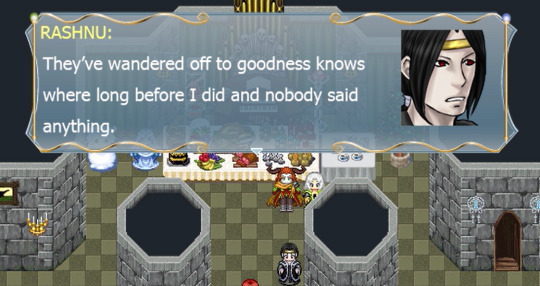
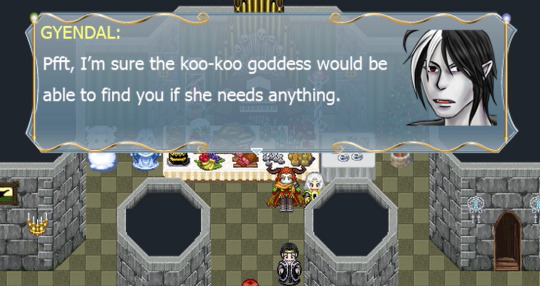

#aveyond#my animation#crack#av1#for the most part#av3 is barely in it#aveyond 1#aveyond daeva#av daeva#av druid#aveyond druid#rashnu#druid rashnu#daeva indra#nanghaithya#daeva nanghaithya#daeva#druid eithera#eithera#gyendal ravenfoot#te'ijal ravenfoot#AM I MISSING ANYONE OMG
0 notes
Text



The Three Catastrophes
These are the three (aparent) main threats for the earlier part of Fragment of Pan. They are beasts of immense corruption which have somehow appeared in the Cosmic Egg.
They are: Typhon, Abaddon, and Indra-Daeva.
Though they clear obstacles in the successful creation of a new world, Professor Vitruvius is certain that his two disciples will be able to steadily deal with these bothersome pests, and grow even stronger in the process.
#Greek Mythology#Abrahamic Mythology#Zoroastrianism#Demonology#Angelology#Typhon#Abaddon#Indra Daeva#Fragment of Pan#oc
7 notes
·
View notes
Text
Varna, Daeva of Ice


A beautiful icy maiden and one of the 7 daevas, fragments of the avatar of ELLUM, the True God and embodies the element of ice. It is said that she was once a beautiful yet vain alfar princess living in the time following the second war, and desired to preserve her beauty forevermore. So, at the ripe young age of 19 she asked the witch Chili Von Nebiros, one of the members of the council of six, to make her beauty everlasting. Chili responded by leading the princess into her laboratory, freezing her solid within a block of ice, implanting her with one of the fragments of ELLUM, and then transforming her into a scion. She was one of the first scions that were created using the "scionify" spell, so her transformation caused her immense pain. The next thing she knew she was in a new, icy body and being attacked by a bunch of strange men in magitek equipment. Morda Vael military. They restrained her and sealed her within an animus, using her as a living weapon against the Ferngulf Republic during the Ferngulf-Vael War. Later once the war was over her animus was left to rot before being picked up by Sero Omnis who was traveling through Baetas Sewer and being resummoned as one of the scions at her disposal using the Summoner class.
In the alternate timeline of Chronicles Black, following the Shattering, angels came down from Mt Celestia in order to find allies and begin their war against the demonic forces. One of these allies were the 7 daevas, as since they were fragments of the True God they would clearly align themselves with the angels in the coming war. So they liberated all the scions they could find from their animus, including Varna, in hopes that they would join the angels in gratitude. They were largely correct with Princess Varna and 5 others, Agenus, Indra, Vayu, Ushas, and Shiva joining the angelic ranks. But one scion remained, Ratri, scion of darkness, who allied herself with the demonic forces.
The 6 daevas aligned with the angels were then sent out across the ravaged planet to guard various areas of importance for the angels. As the second-strongest daeva, Agenus would guard their main HQ, the Santillan Sanctum. Shiva, the strongest daeva by far, would guard the Empyrean Ascent, gateway to the realm of the divine. Vayu would guard the Edenian Windworks, a power plant located on the continent of Eden that would generate mass amounts of energy for the angels using the wind caused by sandstorms. Ushas would guard the Lighthouse, a, well, lighthouse that also served as a storage facility for the angels light-based weaponry, located on Ferris Coast. And finally, Princess Varna would guard the prison located in the Frozen Crater where the angels kept the most dangerous criminals and insurgents awaiting the angel's divine punishment. It was a hard job, but at least Varna was finally free to bask in her favorite environment, the slow-covered winter wonderland of Nifell Isle. At least there she wouldn't melt.
In battle Varna uses primarily water-elemental attacks such as Arcfrost, Blizzard, Avalanche, and her signature attack Diamond Dust. She can also use various status moves like Sexy Dance, Kiss of Death, and Water Break. She is weak to smash, fire, and dark, resists slash and strike, nulls light, and absorbs water.
Her design is based on Shiva from World of Final Fantasy.
#pixel art#pixel sprite#sprite art#pixel graphics#pixel aesthetic#pixelart#gamedev#indiegamedev#indie game#rpg maker#monster girl#monster#monster art#creature design#ice witch#fantasy character#fantasy#final fantasy#fantasy art#fantasy illustration#world of final fantasy#fantasy rpg#rpg#roleplaying#indie rpg#anime and manga#anime art#anime#anime fanart#cute anime girl
8 notes
·
View notes
Text
Vayu, the warrior god of wind
I kind of wanted to fit something about the Iranic Mairiia into my Dracula article in order to discuss the worship of warlike gods as bart of a discussion of the barbarian in relation to Paganism, and then I ran into some fun ideas about Vayu, and Indo-Iranian god of wind who was also one of the warlike deities that were worshipped by the Mairiia.
To start with, let's reintroduce the subject of the Mairiia warriors, via "Anahita: A History and Reception of the Iranian Water Goddess" by Manya Saadi-nejad (2021; p.113-114).

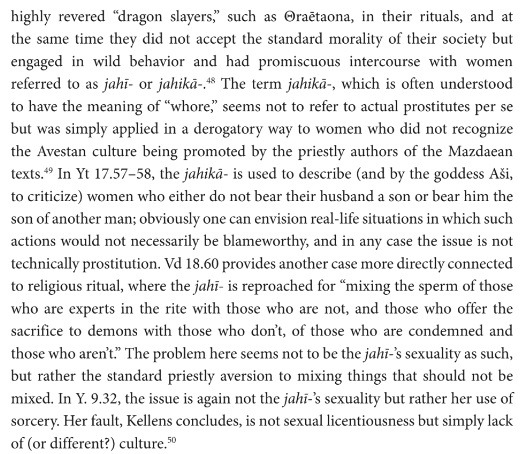
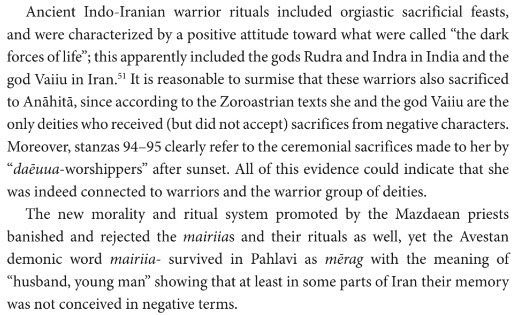
Vaiiu here seems like an Iranian name for both the wind and a complicated character of within Zoroastrianism, perhaps the Iranic form of the Indian Vayu. On the one hand he may have been perceived as a daeva, or at least had daevic characterisitics. On the other hand, he may have received the veneration of a yazata. One of the Yashts, the Ram Yasht, is devoted to Vayu. Here Vayu is honored, is the recipient of sacrifice, and appears to Zarathustra as the one who puts the spirits of good and evil in their place and spans both worlds.
In "Witches, Whores, and Sorcerers: The Concept of Evil in Early Iran" (2011; p.155-156), S. K. Mendoza Forrest discusses another aspect of Vayu: his identity as a warrior.
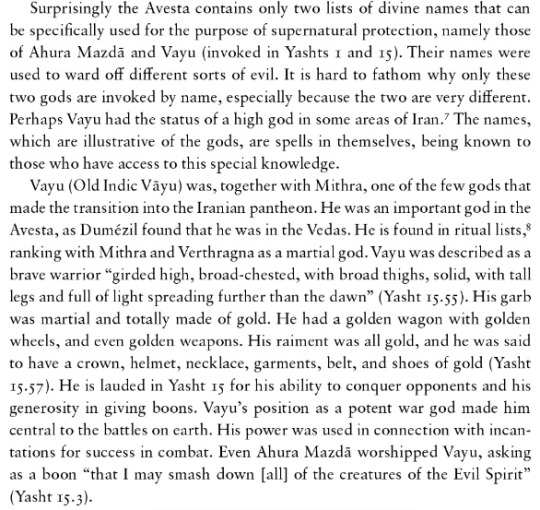
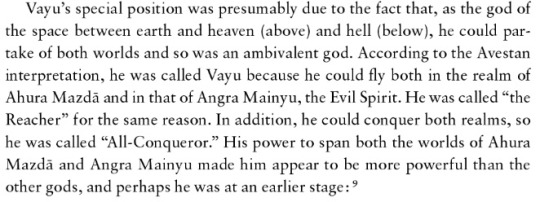
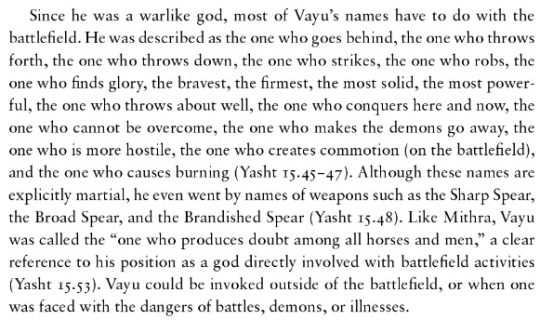
Forrest notes that Vayu does share multiple epithets with Ahura Mazda, but while Ahura Mazda was regarded as a moderately-tempered creator who could also be invoked against supernatural threats, Vayu was seen as a warrior god who could be invoked in war against enemies in battle.
Back to "Anahita: A History and Reception of the Iranian Water Goddess" by Manya Saadi-nejad (2021; p.59), we also see that Vaiiu, alongside Anahita, was believed to be worshipped by some of the villains of the Avestan narrative, including Franrasyan and even Azhi Dahaka.
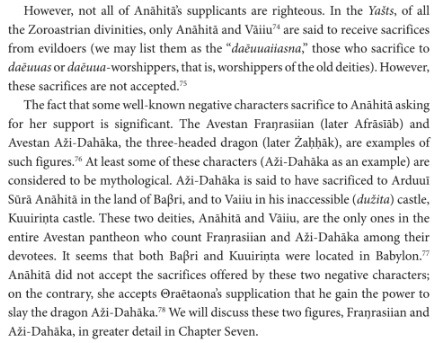
"Mairiia", in the Avestan context, was a word sometimes to refer to these villains (p.59-60), and also as a demonic/negative adjective for "young man". Their villainy also connected to the practice of older pre-Avestan Iranic rites that involved nocturnal (chthonic) sacrifices.

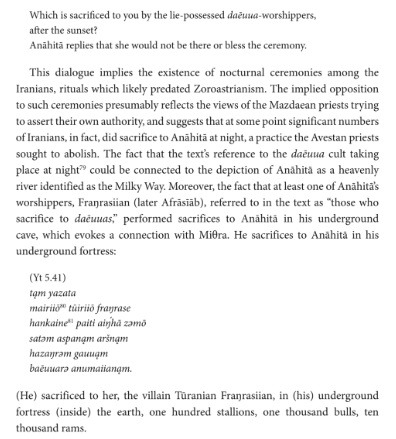
Vayu's warrior god status could in some way be seen, perhaps ironically, as an echo of his worship by the Mairiia as one of a number of warlike (in this context) deities, and thus an echo of older pre-Avestan tradition within the wider of body of Zoroastrianism. This aspect appears to be particularly connected to the Iranian worship of Vayu, and is less recognizable in the context of Hinduism. However, it is possible that Indra, the leader of the Devas, may have inherited warlike characteristics previously associated with Vayu.
According to Georges Dumezil in "The Destiny of the Warrior" (p.73), Vayu had an original function as warrior until later, when Indra rose to prominence in the Vedic pantheon and Vayu's warrior aspect was transferred to either Indra or Bhima, the latter a son of Vayu.
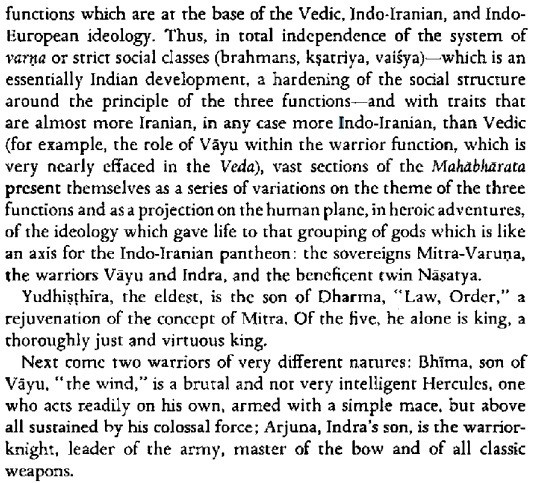
Later in the same book (p.90), Dumezil asserts that there are two kinds of war god in the Rig Veda: one represented by Vayu, the other by Indra.
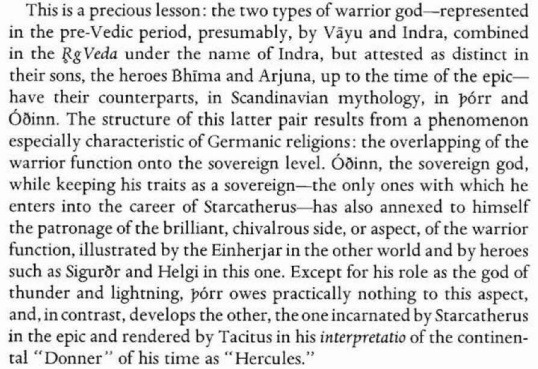
I suppose some small aspect of this must be reflected in his appearance in Japanese Buddhism as Futen, not to be confused with Fujin. Futen appears as an old man in the garb of a military general, and is counted as a member of a group of deities collectively referred to as the Twelve Devas, or Juniten. In Japanese art, the devas (referred to as "Ten" in Japanese) are often depicted similarly wearing the garb of military generals or simply brandishing weapons. These include not only members of the Juniten but also the Shitenno, the Four Heavenly Kings.
So, all in all, Vayu, though popularly remembered mostly as a god of wind, also has a legacy as a warrior god, and perhaps that legacy still persists.
#barbarians#mairiia#paganism#warrior gods#war gods#polytheism#hinduism#zoroastrianism#japanese buddhism#devas#vayu
15 notes
·
View notes
Text

“yə̄ āiiat̰ aṣ̌auuanəm diuuamnəm.”
— Hā 31.20
“The one who abides to Asha (Ashavan) shall attain the Celestial Lights/Divinity (Divam).”
The reward of the sustainer of Order/Truth (Asha), the righteous individual, is “brilliant fame”, the Abode of Light and Song itself. A happy existence, basically.
*djumnám 'divinity' (cf. O.Ind. dyumná- 'divinity, divine glory', O.Av. diuuamnəm 'id.'), from PIE *djḗus 'sky, heaven; sky god'. It could also be from an earlier Pre-PIIr. *djumnó-...
#zoroastrianism#zoroastrian#religion#indo european#indo iranian#spiritual#I have beef abt the words derived from dyeus#too many ppl say we demonized the word bc of the daeva situation#which is completely false#even if that was true#Vedic/post-Vedas viz. Hinduism/dharmic faiths inverted the meaning of asura#and the way many rigvedic gods like Indra are treated are… questionable to say the least
32 notes
·
View notes
Text
Aveyond: Divergent Fate P2.5
A/N: I messed up. I missed this cut scene. I’m so sorry. Also this didn’t fit with either Part 2 or Part 3 so. Part 2.5 it is.
--
Indra reports to Ahriman - they didn't capture Talia, but instead, they captured Rhen. Ahriman is initially displeased. Indra looks into Rhen's fate and finds out she's the new chosen, whose powers can either destroy him or aid him. Pleased with the development, Ahriman decides that they should sway her to the other side.
The Sun Priest, Dameon's father, suggests doing so through his son. He is confident that Dameon never acknowledged Devin as a father, holds contempt for Talia, but treasures Rhen so deeply. The Sun Priest plans to use those feelings to make Dameon protective of Rhen, and remove Devin’s and Talia's influence from her, so that she would be vulnerable to the darkness.
As the men plan, Indra hisses. Her divination sees a potential roadblock to their plan, an anomaly of fate - Lars Tenobor, a twisted boy with a hidden, locked-away heart. Agas steps forward and proposes a different plan - use Lars instead of Dameon to drive Rhen into spiraling madness and despair enough to cling to darkness.
Agas and the Sun Priest argue. Ahriman, the twisted demon that he is, puts them in into a "friendly" competition and promises a reward for the one whose plan succeeds better. In distaste, the two leave immediately.
Then, Ahriman gives each of his other daevas a druid's soul to increase their power. He tells them to prepare - to either face the girl as an enemy, or to welcome her as one of them, by giving her the power contained in the soul orbs, and therefore a taste of what she might have should she join him. Ahriman expects that the daevas will have to give up the souls, either way. Besides, he had already drained the souls of majority of that power.
Satisfied with their scheming, the daevas leave to terrorize Aia.
6 notes
·
View notes
Note
Quoth Wikipedia, the Daevas are from the earliest books of Zoroastrianism, "gods that are (to be) rejected". This sounds awfully familiar. Is it at all likely that Meguro took some level of inspiration from this in his lyrics?
Not a chance! I continue to believe that all the voices in the Nocturne battles are sampled, because they are overall meaningless to the themes of the game. There was lots of sampling going on in the Japanese composition scene around then. For example, Chrono Cross uses sampled sequences I would later hear on a History Channel show, and P3′s Iwatodai dorm theme’s raps are from a sample pack. I COMPLETELY forgot we found the battle voices are combined text-to-speech + Meguro’s own voice. So, samples: no, but Meguro copying/pasting stuff from the Bible: maybe.
But because you gave me the opening, here’s a collection of some recent thoughts about Ahura Mazda and SMT. Yes, the few times Ahura Mazda appears beyond Megami Tensei II, he’s Chaotic. Yes, it’s because of the conflation with Asura. And yes, I think that would still be the case if he came back in a new game. Dx2 brought Tenma back, but I doubt it would be needed in a main game with Fury around, so a Fury Ahura Mazda would be. But we’ll get back to that. (Side note: an anon sent me a while back that Dx2 Agni looks neat–YES!)

Moving on to that Asura (specifically Ashura King-Ahura Mazda) connection that always manages to find its way to the surface. I did a straightforward search for “ahura mazda in hinduism.” This Quora answer to a question about Ahura Mazda and Brahman links Ahura Mazda to a figure from the Rig Vedas I’ve never heard of before: Asura Pitr (in Japanese, アスラ・ピトリ; not exactly a popular term, though); pitr like pater, father or patriarch. Is this is the actual missing link that connects Vairocana to Asura to Ahura Mazda?
Probably not, it turns out. The Quora answerer seems to be a lone wolf. The episode of the Rig Vedas in question (10.124) is about Indra trying to get a number of gods (Agni, Varuna, Soma) to his side and reject this Asura Pitr (hey, rejection). Here are some quotes:
1. (Indra, speaking for the Devas:) Come hither, Agni, to this our sacrifice, of five ways, three-fold, and seven-threaded. Be our oblation-bearer, our leader too! Long, too long hast thou lain in darkness.
2. (Agni:) Leaving the Non-Deva secretly and by hidden ways, as a Deva, foresighted, I go to immortality. When [Asura Pitr](tho) gracious I ungraciously desert, I go from my natural friends to a strange household.
3. (Varuna:) Seeing (that) the guest (i. e. Agni) (is now) of the other branch, I measure out many ordinances of the sacrifice. I say farewell to the Asura Pitr, I go from the portion that is without sacrifice to that which has the sacrifice.
4. (Soma:) Many years have I passed within him. (Now) I have chosen Indra and desert the father.
This is discussed in an old article by Indologist W. Norman Brown, who assumes that Asura Pitr is Vritra. Makes sense, considering the noted rivalry between Indra and Vritra. The Asura are also not entirely demonized yet as of 10.124, just another class of gods who may nonetheless be going out of style, albeit at a rapid pace once the others leave Vritra behind. Brown died in the ‘70s but this Vritra assumption still seems common; otherwise the popular notion is that Ahura Mazda’s laws and contracts are cognate to Vedic Varuna or Mitra.
All this to say that none of what I just went over is going to matter to SMT, because in its eyes, Ahura Mazda and Asura are one and the same. Thus, my recent revelation: Ahura Mazda would be eligible to do anything Asura-oh has done, though this mostly entails being a Chaos rep. Or, maybe more sensibly Neutral/Deity because that’s what he was in MT2, plus that’s what Vairocana is. Either way, hopefully Ahura Mazda will avoid having to complain about desiring his true form, Ahura Mazda.

However, here’s Zurvan from the SMT if… cell phone game. You can already feel the dread-dumb approaching, I know. I’ve said in the past that the dualism of Zurvan and its/their sons Ahura Mazda and Angra Mainyu will be impossible for Atlus to ignore as they run out of demiurges. @b-reis did me one better and suggested a scenario where Mazda and Mainyu will fuse (overlayed with only the most inappropriate symbols, naturally) to create Zurvan. When Devilman is a primary source, nothing matters! Everyone is everything, simultaneously! It is impossible to reject “another” god, because once you reject one, you reject them all!
13 notes
·
View notes
Text

Angra Mainyu (angry mind, the Persian Devil)
Ahriman, also called Aingra Mainyu, meaning “angry mind” is the devil of Zoroastrianism. He is the main adversary of Ahura Mazda, or of the holy creative spirit, Spenta Mainyu.
Zoroaster may have been the one who originally came up with the concept of Angra Mainyu. In Yasna 30.3, the opposing force is “aka mainyu,” Meaning evil mind. This expression of an evil mind, or evil thought was applied to not only Ahriman, but also the daevas or demons within his realm. It was also applied to the human condition.
This relates to the Microcosm and Macrocosm described by the Hermetic philosophers, “As above so below.” The forces within the cosmos are reflected in the human personality like a mirror.
In later Zoroastrianism, the daevas are evil demons, but in the time of Zoroaster, they were described as “wrong gods,” or “false gods.” They were gods to be rejected, yes, but still gods which had a following at the time. This is made clear by the fact that we find Indra, and Rudra, both Hindu gods, among the archdevils of Zoroastrianism.
These daevas, or “false gods” are described as being born of evil thinking. The "deceiver," not identified in the holy text, but probably Angra Mainyu, convinced the daevas to choose "worst thinking." Compare this with the Christian idea of Satan leading a rebellion of angels.
The hell of the wicked is the dwelling place of Angra Mainyu, and "worst thinking." The place of the wicked might be compared to the Christian Hell, the kingdom of Satan and the angels who follow him.
The Vendidad is a part of the Avesta. The name of the texts, a contraction of “Vi Daevo Data” meaning “given against the Daevas,” is a detailing of various demons, and ways to fight back against their attacks. Once again, the daevas are the “false gods” or “wrong gods described by Zoroaster. Aeshma daeva, the daeva of wrath, who would later become known as Asmodeus.
Angra Mainyu, and Spenta Mainyu battle for divine glory. In some verses of the Yasna, these two principles are said to have created the world, which seems to contradict the Gathas, the holy writings of Zoroaster, which declare Ahura Mazda to be the creator.
Yasna 15.43 places Angra Mainyu as the chief of the daevas, in a nether world of darkness, but other passages describe him dwelling in the region of the daevas, which the Vendidad states is in the north. Notice the parallels between this and the Christian idea of Satan as the ruler of the demons, residing in Hell.
0 notes
Text
Persona info no one asked for pt. 2

Arcana: Devil
“Devil Arcana represents the urge to do selfish, impulsive, violent things, and being a slave to ones' own impulse and feelings. Occasionally, it is also portrayed as a symbol of temptation. The positive aspect, however, represents a healthy bond or commitment.”
Human characters associated with the Devil Arcana are often "devilish" individuals; they can be greedy, proud, lustful, or otherwise of poor character. It is not uncommon for this type of character to have somewhat of an antisocial tendency, often not caring much for the needs or well-being of others. Although this is true, they are also characters that are committed to a cause, usually being their work.
Persona: Aka Manah Origin: Zoroastrian mythology Also Known As: Akem Manah, Akoman, Akvan
His name means “manah made evil”; in this case, the word “manah” represents “the mind”. Many refer to him as the demon of “evil intention”, “evil mind”, “evil purpose”, or “evil thinking”. Aka Manah is the demon of sensual desire that was sent by Ahriman (Angra Mainyu) to seduce the prophet Zoroaster. His eternal opponent is Vohu Manah.
The concept of aka manah is already attested in the Gathas, the oldest texts of Zoroastrianism. In Yasna 47.5, Aka Manah is the motivation (the state of mind) that causes deceitful actions. Aka Manah is said to be a property of the daevas, entities that in later Zoroastrianism are demons but in the Gathas are gods that are to be rejected. There, in Yasna 32.3, the daevas are identified as the offspring, not of Angra Mainyu, but of Aka Manah.
According to Denkard 9.30, Aka Manah causes a mortal's failure to discriminate between good and evil. He introduces discord and - as a consequence - physical evil in the world. He perverts a man's thoughts and makes him miserable.
Ultimate Form: Angra Mainyu Origin: Zoroastrian mythology Also Known As: Ahriman
Angra Mainyu is seen as a chaos god as well as a destroyer deity - although he is also seen as "evil", he is not recognized as a god of evil, though he does come close. His name means "destructive spirit" or "frightful spirit". He is the evil twin brother of Spenta Mainyu or Ahura Mazda; the “Wise Lord.” Everything that the latter one did, Angra Mainyu would do the opposite. He was also responsible for all hardships man had to endure in the world.
In the beginning of time, when Spenta Mainyu created all the good things in the universe, Angra Mainyu, out of jealous spite, sent demons to spoil all of creation. Spenta Mainyu welcomed his brother benevolently and with words of peace, but Angra Mainyu spurned him, and so Spenta Mainyu casted the evil destroyer back into the darkness from whence he came.
Angra Mainyu rules over the Daeva, which are similar to demons in other religions. He has numerous assistants who help him fulfill his role as Evil Spirit. The main ones are Aka Manah (Evil Mind), Indra Vayu (Death), Saurva (Disease), Aeshma (Violence and Fury), Az (Lust, Greed, and Jealousy), Mithandruj (Dishonesty and Lies), and Taurvi and Zairicha, also known as Tauru and Zairi (Fever and Thirst).
Jin acquires Angra Mainyu after overcoming his constant distrust (disdain) of others and finally comes to depend on (and care for) protagonist. Against his self-preservation rationale, he moves to protect protagonist from an impending blow. His desire to protect someone he cares about strengthens his resolve and calls forth Angra Mainyu, vanquishing the foe. Jin remains loyal to protagonist and sees him/her to their final goal.
Note: The dialogue of this event changes depending on his SLink level.
Low SLink: "You are supposed to be the leader and yet you allow yourself to fall into this position. Learn quicker." High SLink: "Truly, you are a handful. If you die here how am I supposed to unravel you any further? I suppose I have no choice but to keep a more watchful eye on you." Romanced SLink: "You said that you would take care of me, no? How will you do so if you are dead? Pay attention."
Stats
Element: Dark, Ice Weakness: Light, Fire Absorbs: Ice Block: Dark
(Level 99) Strength 60 Magic 99 Endurance 61 Agility 68 Luck 75
Playstyle
Jin’s moveset revolves around debuffing and taking advantage of enemies’ weaknesses. He comes with skills like Tarunda, Sukunda, Poison Mist, and Bufu. With his high Magic stat, he will have a tendency to use Mind Charge (when he learns it) at the beginning of a battle before attacking if he is set to Offensive stance. He also might abuse Mudo skills when he gets them.
When facing enemies without weaknesses, he has a habit of casting Tentarafoo, Evil Smile (+Ghastly Wail) or Poison Mist if he is set on Auto.
He isn’t very likely to use his gun since he prefers the more effective Magic skills. If he does, he will likely go for vitals unless the target is human (and killing is not an option), then he will likely aim to disarm them.
#;ooc#;headcanons#//I've been sick and bored okay#//will I ever use this info?#//probably not lmao#//but I wanted to write it out#//my copy of Persona 5 is coming soon and I'm hyping myself up by doing stupid things#//admittedly part 1 was on my old blog and was deleted so oops#//lol @ different route responses...can you tell i play too may otoges?#hc1#v; 悪魔の荊約 (persona verse)
7 notes
·
View notes
Photo

Vritra ヴリトラ, Vuritora #Vritra #ヴリトラ #Vuritora Vritra the Enveloper is both an Asura and a dragon. He is the embodiment of drought and the enemy of Indra. Once upon a time he stole and kept all the world's water to himself, but he was eventually defeated by Indra. Later versions of the myth have him as a loving worshiper of Vishnu who eventually turned evil and forsook his duty as a being of good to become the leader of the demonic Asuras and battles the Daevas, while in others he is a creation of Tvastar made to avenge his son who was murdered by Indra.
2 notes
·
View notes
Text
پیش درآمدی بر اساطیر ایران
مهاجرت تاریخساز آریاییان از آسیای میانه بهسوی سرزمین ما در حدود دوهزارسال پیش از میلاد انجامگرفته است. پس از مهاجرت، آریاییان که اصطلا��اً آنها را هندواروپاییان مینامند، در سرزمینهای مختلفی پخش شدند. گروهی دیگر از دالان قفقاز راهی غرب و سرزمینهایی شدند که امروزه آنها را اروپا مینامیم و گروهی دیگر در مناطق وسیعی از آسیا سکنی گزیدند. دسته اخیر که هند و ایرانی نامیده میشوند، خود به دو گروه تقسیم شدند. گروهی راهی هند شدند و گروهی دیگر فلات ایران را برای سکونت انتخاب کردند؛ ولی مشترکات نژادی و فرهنگی میان این دو گروه هرگز گسسته نشد. مردم در دوران باستان سرزمین ما با مردم دوران باستان سرزمین هند همبستگیهای بسیاری داشتند. این موضوع، بخصوص در زبان، اسطورهها و مسائل مربوط به آیینهای آنها آشکارا دیده میشود که گویای هم��یستی طولانی ایرانیان و هندویان آریایینژاد است. گروهی که در سرزمین ما ماندند نام خود، ایران، را به این سرزمین دادند و فرهنگ و اساطیر آیینهایشان احتمالاً از فرهنگ بومی این سرزمین تأثیر پذیرفت. سپس آیین زردشت در حدود ۱۲۰۰ تا ۱۰۰۰پیش از میلاد ظهور کرد. پیش از آمدن آیین زردشت، خدایانی در اندیشههای مردمان این سرزمین ستایش میشدند؛ خدایانی که به دوران همزیستی مردم ایران و هند و بهعبارتدیگر به دوران هندو ایرانی تعلق داشتند. این خدایان که ما در طی شرح اساطیر ایران گاه با صفت«کهن» یا پیش زردشتی توصیفشان خواهیم کرد، در زیر لوای اعتقادات زردشتی قرار میگیرند و همگی در منتهای دینی، آفریده «مزدا» معرفی میشوند. مزدا که به معنی خرد و فرزانگی است و سپس لقب اهورا به معنی سرور در آغاز نام او قرار میگیرد احتمالاً خود یکی از مجموعه خدایان پیشین بوده که زردشت مقام بالاترین خدا را برای او قائل شده و خدایان دیگر را، با سلسله مراتبی، تحت سلطه او دانسته است.
برخی از محققان۱ وظیفه خدایان هندو ایرانی را با طبقات سهگانه جامعه هندواروپایی تطبیق دادهاند. این طبقات سهگانه عبارت بودند از فرمانروایان و روحانیان، ارتش تاران (نظامیان و جنگجویان)، کشاورزان و پیشه وران و دست ورزان.
این مطلب در مجموعه خدایان ایرانی بهطور واضح دیده نمیشود، ولی در گروهبندی خدایان هندی کاملاً مشخص است. خدایان دوران ودایی هند به سه گروه تقسیم میشوند:
گروه اول: خدایان فرمانروا و روحانی یا اسوره ها۱*(اسوراها) در رأس این گروه ورونه قرار دارد که خدایی است بزرگ و باابهت که نخست فقط خدای گنبد آسمان بوده است. قدرت او در هند همسان باقدرت اورمزد۲ در ایران است و همچون او آفریدههایی مانند آمشاسپندان دارد که آدیتیه۳ ها نامیده میشوند.
یک خدای فرمانروا
یکی از همکاران او میتره یا میتراست که مفهوم پیمان و دوستی دارد و ترکیب میتره – ورونه، رته۴، نماد نظم و ترتیب است که در ایران در شخصیت اردیبهشت، یکی از امشاسپندان، ظاهر میشود.
از دیگر همکاران این گروه خدایان هندی میتوان از اریامنه۵ (در ایران اریامن) وبغه۶ (در ایران بغ) نام برد.
گروه دوم: خدایان ارتشتار یا دَئِوَه۷ ها (دیوها) این گروه خدایان، خدایان جنگجو هستند که در رأس آنها ایندره۸ قرار دارد که خدای طوفان است و به وجود آورندۀ بارانهای سیلابی. همچنین خدای جنگ و نبرد نیز به شمار میآید و پشتیبان آریاییان و همراه جنگجوی ودایی است. این خدای برجسته گروه دوم خدایان هندی بعدها در ایران بهصورت «دیو»مقابل اردیبهشت امشاسپند قرار میگیرد.
روده سَروه و وَیو نیز از همکاران ایندره هستند.
گروه سوم: خدایان مظاهر طبیعت این خدایان جلوههای گوناگونی را از طبیعت تجلی میبخشند، مانند اوشاس(ایزد سپیده دم)؛یاویتا ویشنو (خدایانی که با خورشید ارتباط دارند)؛ اگنی(خدای آتش)؛ سومه(در ایران هومه) نماد نوشیدنی شفابخش.
خدای باران
این تثلیت ریشۀ کهن آریایی دارد. در هند دوران ودایی، خدایان این گروهها همگی موردستایش و نیایش قرار میگیرند و از گروه اول(اسوره ها) و از گروه دوم (دَیوَه ها) یکسان درخواست حاجت میشود. یعنی در آغاز، این دو گروه خدایان باهمزیستی دارند، اما رفتهرفته در برابر هم قرار میگیرند و کمکم در سرودهای متأخر از دشمنی میان آنان گفتگو میشود. این موضوع، بخصوص در مورد ورونه و ایندره صادق است. از سوی دیگر، ایندره که خدای ارتشتار و از تبار دئِوه هاست با رته که از گروه آسوره ها و همکار نزدیک ورونه و نماد نظم و سامان بخشی است هیچگونه سازشی ندارد.در منتهای متأخرتر هندی رقابت این دو گروه دیگر یعنی اسوره ها از سریر خدایی به مرتبۀ ضد خدایی تنزل داده میشوند. تنها اسوره های بزرگ مانند ورونه و میتره پس از چشمپوشی از صفت اسورایی به گروه خدایان دیوی میپیوندند و جزء خدایان باقی میمانند. در وداهای متأخر، اسوره ها همه بهصورت موجودات نابکار درمیآیند.
در گذار این اندیشهها به سرزمین ایران، اسوره به اهورا(اور) تبدیل میشود و با منی سرور بزرگ ب عنوان لقب مزدا به کار میرود و آفریدگار بزرگ، اهورامزدا نامیده میشود. در منتهای کهن ایران، لقب اهورا به دو خدای دیگر نیز اطلاق میشود: یکی میترا و دیگری اپام نپات(تخمۀ آبها)؛ ولی این لقب مانند اهورامزدا بانام آنها ترکیب نمیشود.
دئِوه ها در ایران نخست بهصورت خدایان بیگانه و سپس خدایان دشمن درمیآیند و سرانجام مفهوم امروزی«دیو»را پیدا میکنند. بهعبارتدیگر، خدایان مهم گروه دوم خدایان هندی یعنی دئِوه ها در اندیشههای ایرانی بهصورت دیوهای مهم درمیآیند که در برابر خدایان اصلی و بخصوص امشاسپندان قرار میگیرند.
۱.اسوره یا اسورا(َAsura) برابر با اهوره یا اهورا در ایران است. این لقب در ��غاز نام مزدا دیده میشود. فتحه آخر در این اسمهای خاص گاهی با «اُ» و گاهی با «ه/هَ» نشان داده میشود. ازاینرو، بهعنوانمثال، هم صورتنگارشی و رونه و میتره و هم صورت ورونا و مترا دیده می شود.
۱*دومزیل (Dumezil)دانشمند اسطورهشناس فرانسوی و پیروان مکتب او
۲اهورا مزدا، اوهرمزد، اورمزد و هُرمزد گونههایی از یک نام واحد در دوران زمانی متفاوت هستند. ما در این کتاب صورتنگارشی اورمزد و اهورامزدا را برگزیدهایم.
۳.Aditya
۴.Rta
۵.Aryamana
۶.Bagha
۷.Daeva
۸.Indra
منبع:
کتاب تاریخ اساطیری ایران، اثر ژاله آموزگار، انتشارات سمت، چاپ شده در مهر ۱۳۹۵
تهیه الکترونیکی: سایت تاریخ ما، اِنی کاظمی
نوشته پیش درآمدی بر اساطیر ایران اولین بار در تاریخ ما. پدیدار شد.
source https://tarikhema.org/ancient/29192/%d9%be%db%8c%d8%b4-%d8%af%d8%b1%d8%a2%d9%85%d8%af%db%8c-%d8%a8%d8%b1-%d8%a7%d8%b3%d8%a7%d8%b7%db%8c%d8%b1-%d8%a7%db%8c%d8%b1%d8%a7%d9%86/
0 notes
Photo

Indra, as a Deva and as a Daeva.
7 notes
·
View notes
Photo

Posting an alternate version of my Indra painting minus the Rise of the Guardians logo. Just because the logo wouldn't make any sense to anyone unless the full image is complete. Which, in retrospect, I should be working on...
4 notes
·
View notes
Photo



1. Indra, the Vedic god of thunder and king of the Devas. In Zoroastrianism he was demonized as a Daeva, an evil deity.
2. Teshub, the Hurrian sky god.
3. Nemesis, the ancient Greek goddess of retribution.
#angelology#demonology#Vedic Mythology#hinduism#Zoroastrianism#hurrian mythology#Greek Mythology#Indra#teshub#nemesis#oc
10 notes
·
View notes
Photo

Indra is the Vedic god of war and thunder, who lead the Devas and was famous for his heroic slaying of the evil Asura Vritra.
However, in Zoroastrianism he was vilified and became a Daeva, an evil demon. One is instructed to say “I hostilely engage Indra” when combating the Nasu Druj.
4 notes
·
View notes